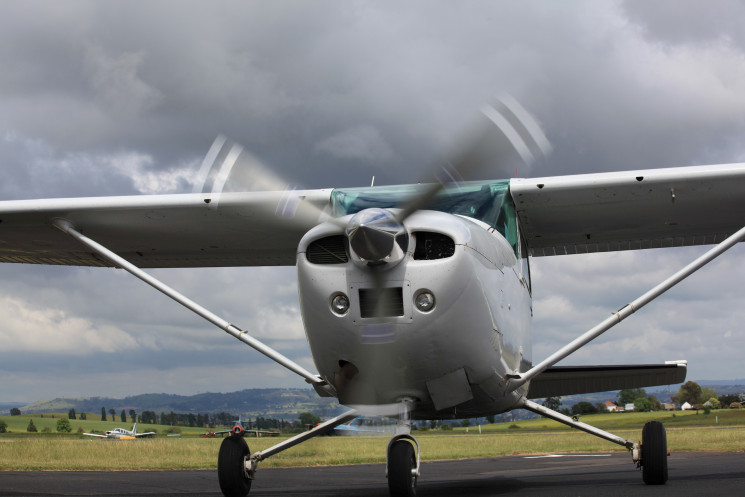The Civil Aviation Safety Authority is reminding pilots and operators of the importance of properly restraining cargo and baggage following a recent surveillance sweep across Australia's Top End.

Two unannounced sweeps in Australia's Top End by Civil Aviation Safety Authority inspectors found operators are largely adhering to safety regulations.
The surveillance sweeps included fixed wing and helicopter operations, including those involved in scenic flights.
The first sweep in Northern Queensland and the Torres Strait included an examination of aircraft, maintenance releases and how operators recorded hours.
CASA officers visited Bamaga, Punsand Bay, Loyalty Beach and Seisa before heading to Thursday and Horn islands and then to Coen, Weipa, Musgrave Roadhouse, Archer River Roadhouse, Hopevale, Elm Beach, Cow Bay and Cooktown.
The second operation covered Western Australia's North-West and included ramp checks in Kununurra, Halls Creek, Fitzroy Crossing and Derby.
CASA's National Manager Surveillance, Russell Dyer said the visits provided a valuable insight about what was happening with operators in remote communities and how they worked.
'It also provided a greater CASA presence and visibility in the remote areas of Australia,' he said.
While there were minor deficiencies with some aircraft, a wider issue to emerge from the West Australian visits involved the restraining of baggage and items such as first aid and survival kits.
The inspectors found items that were either not restrained, or the restraining system was insufficient, in all but two of the aircraft they checked.
'Loose items can pose a safety hazard and pilots need to ensure items in the cabin are appropriately restrained,' Mr Dyer said.
'As a result of the finding, CASA is issuing additional advice to make sure pilots and operators are aware of their responsibilities.'
Information on CASA's Flight safety Australia website outlines what cargo can be carried in a cabin as well as where and how it should be stowed.
It cannot, for example, be stowed in toilets or against bulkheads, in a way that prevents an overhead locker from being latched or where it impedes access to emergency equipment.
CASA's inspectors also met representatives of four indigenous communities: Binarri Binyja Yarrawoo in Kununurra, Jungarni Jutiya – Indigenous Corporation , Marra Worra Worra in Fitzroy Crossing and Nyamba Buru Yawuru in Broome.
'People in remote communities do a lot of air travel in small aircraft but they're not that confident about reporting if they see something they're not happy about or that appears wrong,' said Manager Surveillance Ron Salter, who was at the meetings.
'We spend a bit of time explaining our reporting process, where to find the forms and how to complete them, and encouraging them to contact us if they have any issues.'
Media contact
-
Aircraft
-
Aircraft registration
- Change, transfer or cancel aircraft registration
- Data files for registered aircraft
- Ferry flight registrations
- Find a registered aircraft
- Guidance for deceased estates
- Irrevocable deregistration and export request authorisation (IDERA)
- Register your aircraft
- Registered aircraft operators
- Registration marks
- Request a copy of your registration certificate
- Airworthiness
- Certification
- Design and manufacturing
- Sport aviation
-
Aircraft registration
- Drones
-
Licences and certificates
- Pilots
- Radio operators
- Air traffic controllers
-
Air operators
- Aerial application air operator's certificate
- Aerial work certificate (Part 138)
- Air transport air operator's certificate
- Alternative pathways for specialised endorsements
- Balloon air operator's certificate
- Flight training operators
- Foreign operators
- Guidance for Part 91 approvals
- Replace air operator's certificate
- Aerial photography from aircraft
- Delegates
-
Maintenance engineers
- About aircraft maintenance engineers
- Aircraft maintenance engineer exams
- Aircraft maintenance engineer licence (Part 66)
- Apply for a Part 66 licence
- Become a licensed aircraft maintenance engineer
- Maintenance of composite structures
- Part 66 and working for a Part 145 organisation
- Part 66 self-study training and examination pathway
- Recognition of prior learning
- Removing exclusions
- Licence currency and requalification
- Modular licensing for aircraft maintenance engineers
- Part 66 modular aircraft maintenance engineer licence pathways
- Flight examiners
- Flight instructors
- Aviation medicals
- Medical professionals
- Aviation reference numbers
- English language standards
-
Operations, safety & travel
- Aerodromes
- Airspace
- Aviation safety for pilots
- Safety Management Systems
-
Safety advice
- Cabin safety
- Carriage or discharge of firearms on aircraft
- Community service flights
- Cost sharing flights
- Dangerous goods and air freight
- Displays and events
- Drug and alcohol management
- Electronic flight bag
- Fatigue management
- Hazard identification and management
- Human factors and safety behaviours
- Mercy fights and operating in an emergency
- 5G and aviation safety
- Consumer and passenger advice
- Aeronautical information management
- Rotorcraft performance standards for flight operators
- Training and checking systems
-
Rules
- Regulatory framework
- Rules by category
- Rules by status
- Rules by type
- Changing the rules
-
Compliance and enforcement
- Delegated authority in support of aviation safety investigations
- Enforcement action
- How to comply with the rules
- Recent enforcement actions
- Safety information policy statement
- Sharing safety information
- Strict liability
- Surveillance
- Voluntary suspensions
- Recent enforcement actions
- Reporting unsafe behaviour
- Resources & education
-
About us
- Who we are
- Who we work with
- News, media releases and speeches
-
Reporting and accountability
- Environmental management and performance
- Freedom of information
- Gift and benefits register
- Gender pay gap employer statement
- List of CASA files
- Portfolio budget statements
- Register of privacy impact assessments
- Regulator Performance Framework
- Senate order on agency contracts
- Service standards
- Statement of commitment to child safety
- Work health and safety policy statement
- Protecting the environment
- External security vulnerability disclosure program
- Careers
- Sponsorship and scholarship
- About this website
- Contact us
- Events
- Subscribe

